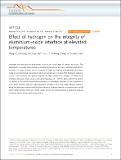| dc.contributor.author | Li, Meng | |
| dc.contributor.author | Xie, De-Gang | |
| dc.contributor.author | Ma, Evan | |
| dc.contributor.author | Zhang, Xi-Xiang | |
| dc.contributor.author | Shan, Zhi-Wei | |
| dc.contributor.author | Li, Ju | |
| dc.date.accessioned | 2017-06-22T20:49:59Z | |
| dc.date.available | 2017-06-22T20:49:59Z | |
| dc.date.issued | 2017-02 | |
| dc.date.submitted | 2016-07 | |
| dc.identifier.issn | 2041-1723 | |
| dc.identifier.uri | http://hdl.handle.net/1721.1/110184 | |
| dc.description.abstract | Hydrogen can facilitate the detachment of protective oxide layer off metals and alloys. The degradation is usually exacerbated at elevated temperatures in many industrial applications; however, its origin remains poorly understood. Here by heating hydrogenated aluminium inside an environmental transmission electron microscope, we show that hydrogen exposure of just a few minutes can greatly degrade the high temperature integrity of metal–oxide interface. Moreover, there exists a critical temperature of ∼150 °C, above which the growth of cavities at the metal–oxide interface reverses to shrinkage, followed by the formation of a few giant cavities. Vacancy supersaturation, activation of a long-range diffusion pathway along the detached interface and the dissociation of hydrogen-vacancy complexes are critical factors affecting this behaviour. These results enrich the understanding of hydrogen-induced interfacial failure at elevated temperatures. | en_US |
| dc.description.sponsorship | National Science Foundation (U.S.) (DMR-1120901) | en_US |
| dc.description.sponsorship | National Science Foundation (U.S.) (DMR-1410636) | en_US |
| dc.language.iso | en_US | |
| dc.publisher | Nature Publishing Group | en_US |
| dc.relation.isversionof | http://dx.doi.org/10.1038/ncomms14564 | en_US |
| dc.rights | Creative Commons Attribution 4.0 International License | en_US |
| dc.rights.uri | http://creativecommons.org/licenses/by/4.0/ | en_US |
| dc.source | Nature | en_US |
| dc.title | Effect of hydrogen on the integrity of aluminium?oxide interface at elevated temperatures | en_US |
| dc.type | Article | en_US |
| dc.identifier.citation | Li, Meng; Xie, De-Gang; Ma, Evan; Li, Ju; Zhang, Xi-Xiang and Shan, Zhi-Wei. “Effect of Hydrogen on the Integrity of Aluminium–oxide Interface at Elevated Temperatures.” Nature Communications 8 (February 2017): 14564 © 2017 The Author(s) | en_US |
| dc.contributor.department | Massachusetts Institute of Technology. Department of Nuclear Science and Engineering | en_US |
| dc.contributor.mitauthor | Li, Ju | |
| dc.relation.journal | Nature Communications | en_US |
| dc.eprint.version | Final published version | en_US |
| dc.type.uri | http://purl.org/eprint/type/JournalArticle | en_US |
| eprint.status | http://purl.org/eprint/status/PeerReviewed | en_US |
| dspace.orderedauthors | Li, Meng; Xie, De-Gang; Ma, Evan; Li, Ju; Zhang, Xi-Xiang; Shan, Zhi-Wei | en_US |
| dspace.embargo.terms | N | en_US |
| dc.identifier.orcid | https://orcid.org/0000-0002-7841-8058 | |
| mit.license | PUBLISHER_CC | en_US |
